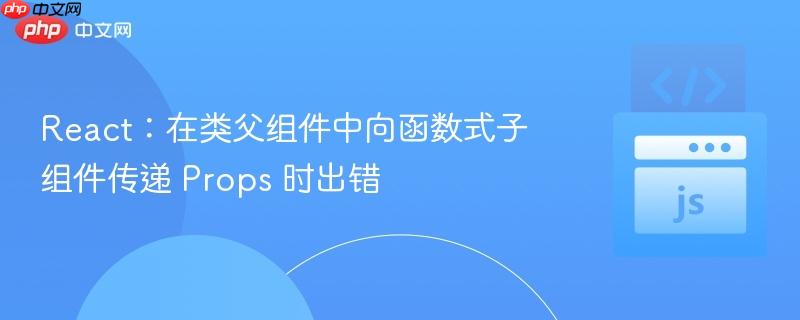
本文旨在解决在 React 类组件中,向函数式子组件传递 props 时遇到的“Cannot read properties of undefined (reading 'apply')”错误。通过分析错误原因,提供了一种更清晰、更模块化的组件组织方式,避免了在类组件内部定义函数式组件,并展示了如何正确地将 props 传递给子组件。
在 React 开发中,我们经常需要在父组件中渲染子组件,并向子组件传递数据。当父组件是类组件,而子组件是函数式组件时,如果处理不当,可能会遇到一些问题,例如 "Cannot read properties of undefined (reading 'apply')" 错误。本文将深入探讨这个问题,并提供一种更佳的解决方案。
问题分析
出现 "Cannot read properties of undefined (reading 'apply')" 错误,通常是因为在类组件内部使用 const 定义函数式组件,并且在子组件内部尝试访问 this.props。 这种方式是不推荐的,原因有以下几点:
解决方案:将子组件独立定义
更清晰、更模块化的方法是将子组件独立定义,然后在父组件中直接渲染子组件,并将所需的 props 传递给它们。
以下是一个示例:
import React from 'react';
import { View, Text } from 'react-native'; // 替换为你的实际组件库
// 独立的函数式子组件
const GenericChild = (props) => {
return (
<View>
<Text>A: {props.a}</Text>
<Text>B: {props.b}</Text>
<Text>C: {props.c}</Text>
</View>
);
};
// 父组件
export class Parent extends React.Component {
render() {
return (
<View>
<GenericChild a={this.props.a} b={this.props.b} c={101} />
<GenericChild a={this.props.a} b={this.props.b} c={102} />
</View>
);
}
}代码解释:
注意事项:
总结
通过将函数式子组件独立定义,并直接在父组件中渲染,我们可以避免 "Cannot read properties of undefined (reading 'apply')" 错误,并使代码更加清晰、易于维护。 这种方法符合 React 组件化的设计思想,有助于构建更健壮、更可扩展的应用程序。
以上就是React:在类父组件中向函数式子组件传递 Props 时出错的详细内容,更多请关注php中文网其它相关文章!

每个人都需要一台速度更快、更稳定的 PC。随着时间的推移,垃圾文件、旧注册表数据和不必要的后台进程会占用资源并降低性能。幸运的是,许多工具可以让 Windows 保持平稳运行。

Copyright 2014-2025 https://www.php.cn/ All Rights Reserved | php.cn | 湘ICP备2023035733号